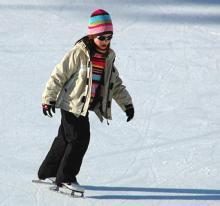
A favorite winter pastime of children through the years has been ice skating. Once enjoyed primarily as a fun recreational activity on a frozen lake or river, ice skating has also developed into competitive events, such as speed skating, figure skating, and ice hockey.
The earliest forms of ice skating appear to have existed for thousands of years. The Scandinavians may have been the first to fashion crude blades out of animal leg bones, such as reindeer, elk, or cows, to build primitive ice skates. By flattening one side of the bones and drilling holes to attach the bones to their feet using leather laces, the skaters could then glide over the ice. The Dutch also have an early history of ice skating, but it is believed that they were introduced to skating on ice by the Vikings around the year 800. By 1180, a book was published describing boys in London playing on the ice with bones strapped to their feet using poles to propel them along.
The transition from using bones to metal blades occurred early in the 13th century. The oldest ice skate in existence today was found in excavations in Amsterdam and is believed to have been made around 1225. It had a wooden platform attached to an iron runner blade that was curved like a prow at the front and right angled at the rear. Art work from the 16th and 17th centuries show similarly designed examples of iron ice skates with the curved blade at the front and varying styles of lacing to attach it to the feet. The style did not change much until the second half of the 1800s when the curved blade and platform were given more support.1
Edinburgh, Scotland has the distinction of forming the first skating club in 1742. The interest in ice skating grew tremendously in the 1800s, and skating clubs were opened in London, Vienna, and New York.2 In 1848, the first all steel clamp for skates was invented by E. V. Bushnell of Philadelphia, allowing skates to be attached to shoes. Jackson Haines, a famous American skater, developed the two plate all metal blade that was attached directly to a boot in 1865. Adding a toe pick to skates in the 1870’s, Jackson combined dance moves, jumps, and spins that would lead to the sport of figure skating. The first artificially frozen ice rink called the Glaciarium opened in London in 1876, and indoor and outdoor rinks were built as modern ice skating grew in popularity.3
Speed skating certainly had its origins with the early ice skaters on the frozen canals and rivers of Scandinavia and the Netherlands. With the development of iron blades, speed competitions were enjoyed and held often between villages. The first known organized speed skating race was held in England in 1763.4
Ice hockey is believed to have evolved from the game of field hockey that was played in Europe in the 17th and 18th centuries. The modern rules for playing ice hockey were drafted at McGill University in Montreal, Canada in 1879, and the game migrated to the United States soon after.5
Until the Dutch introduced the metal blade with sharpened edges to aid in controlling the movement on skates, the early bone skates only allowed a gliding motion across the top of the ice. Today there are three basic types of ice skates depending on their use: speed skates, hockey skates, and figure skates. Speed skates are designed for speed moving in only one direction with the skater moving the right foot over the left. Hockey skates allow for moving in all directions and are equipped with extra padding and plastic caps for protection from other players' blades. Figure skates have a high boot that completely covers the ankle, a toe pick that facilitates jumps, and a steel blade that allows for spinning.6
Young children are often introduced to ice skating by starting on the ice with an ice walker, chair, or plastic cone to help them maneuver on the ice. With their knees bent, backs straight, and heads up, they soon have the feel for the ice and are on their way to enjoying ice skating for fun or training for a sport.7
- 1. “Ice skates and their history.” The Virtual Ice Skates Museum. < http://www.iceskatesmuseum.com/e-historie-1.htm > 2 Feb. 2012.
- 2. McNulty, Mary F. “Ice Skates.” How Products Are Made. Volume 2. < http://www.madehow.com/Volume-2/Ice-Skates.html > 2 Feb. 2012.
- 3. Bellis, Mary. “Ice Skates.” About.com Inventors. < http://inventors.about.com/library/inventors/bliceskates.htm > 2 Feb. 2012.
- 4. “About Speed Skating.” Speed Skating Canada. < http://www.speedskating.ca/about-speed-skating.cfm > 2 Feb. 2012.
- 5. “History of Hockey: Early Years.” History of Hockey. < http://historyofhockey.net/history_of_hockey.html > 2 Feb. 2012.
- 6. Op. cit., McNulty.
- 7. Sigafoos, Stephanie. “How to Teach Kids to Ice Skate.” eHow.com. < http://www.ehow.com/how_2168977_teach-kids-ice-skate.html > 2 Feb. 2012.

